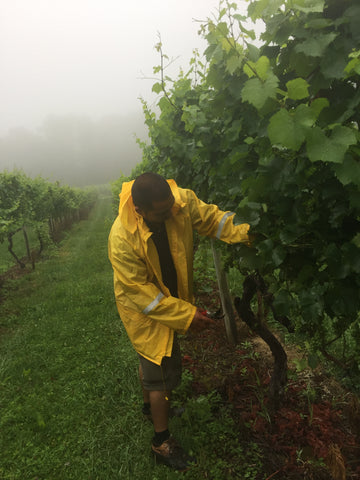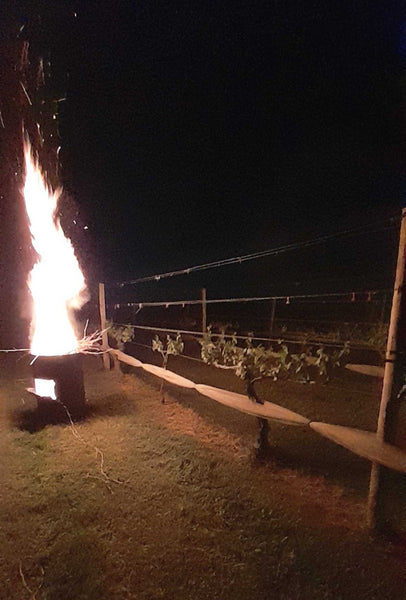Our Crew Works Towards Grand Cru
We are gearing up for harvest here at Unionville, with surefire signs like purpling Pinot Noir and golden Chardonnay reminding us that long hours, stained hands, and an opportunity to craft a whole new lot of sensational wine is just around the corner.
It is my favorite time of year. One of my favorite parts of working in a creative scientific field is our ability to look back on past vintages and learn from time and experiences (just as John described in his last post). This nostalgic analysis allows us to amend and alter different factors in the winery and vineyard in an experimental fashion, with an aim to improve wine quality or just try something different, fun, or special.
This growing season, we have been focusing on examining fruit set and adjusting crop yields, not only to ensure a clean and healthy fruiting zone but also to concentrate sugars, acids, and flavors in a more manageable crop load on the vine.

At Unionville, we like to crop our vineyards at between 2 and 4 tons of grapes per acre of planted vines (depending on the site and variety), and in the United States, we have the option to be fully flexible with this yield control. It is entirely up to us (and the weather) to manage the crop load and growing conditions – which is coupled with the responsibility of controlling the qualitative and economic consequences of our viticulture practices. This may seem like an obvious statement, but in almost all of the long-established winegrowing regions (affectionately referred to as the “old world”) there are rules and regulations controlling everything from allowable grape variety, to crop yields and allowed vineyard maintenance, to aging vessels and nutrient additions in different standards and classes of wine.
The idea of self-policing these strict regulations in an effort to emulate the regulation and standards of quality in our own vineyard practices sounds like an enticing experiment in control and enhancement. We looked to the French region of Burgundy for inspiration, where the designation of “Grand Cru” denotes the most distinct and consistent high-quality winegrowing sites of the area. Our winemaking and winegrowing philosophies for varieties such as Pinot Noir and Chardonnay have deep roots in the northernmost sites of Burgundy, such as Chablis and Dijon. Within these regions, the maximum amount of wine permitted to be made is 40 hectoliters per hectare (~400 gallons per acre) with numbers in various vintages often coming in much lower, this roughly equates to yields of around 1.5 – 2 tons of fruit per acre, so it seemed only right that we followed a similar maintenance procedure.
With that in mind, Alvaro and I chose four rows of our prized Pheasant Hill Chardonnay vineyard to green-thin down to a yield of 1.5 tons of fruit per acre. Venturing out early on a wet and chilly July morning, the two of us dropped more than half of the established Chardonnay clusters to the floor of the vineyard (yes, it was painful for both of us, but it was for the good of Science). By creating this variable and using the rest of the normally cropped Pheasant Hill Vineyard as a control, we hope to learn and further understand the control we have over quality assurance, sugar concentration, and overall wine potential from grape to bottle through this method.
These four rows will be monitored, analyzed, picked, processed, fermented, and aged separately from the control as our “Grand Cru” Chardonnay. As previously addressed, we are hoping to learn a lot about our control over quality potential and excited about the possibility of this small-batch wine being a fantastic addition to our STAMPED wine-club exclusive releases, or perhaps even a one-week-only sale in the tasting room.
No matter what the result of the experiment will be, enacting it has been half the fun and overall, an immensely rewarding experience. We will continue to try new things and start new trends at the winery, and I am sure I speak for all of us when I say how excited I am for the future. Great things happening at Unionville Vineyards – stay tuned!
- Conor Quilty, Associate WinemakerLeave a comment
Comments will be approved before showing up.
Also in Unionville Grapevine

The Best Wines are the Ones You Fight For
We picked from 5am that day until a little past midnight, almost 19 hours of harvesting. The pick was only interrupted for bathroom breaks, pizza, and eventually some beers to keep morale high. I think the high morale beer was Miller High Life, although the details are fuzzy and it would only have been selected ironically. It was the most tenacious day I can recall in the field here. We picked nearly 10 tons from three different vineyards, finishing with the Pheasant Hill Chardonnay. We saran wrapped the bins during transport and weighing back at the winery as Ophelia's first raindrops splashed down just after midnight.


